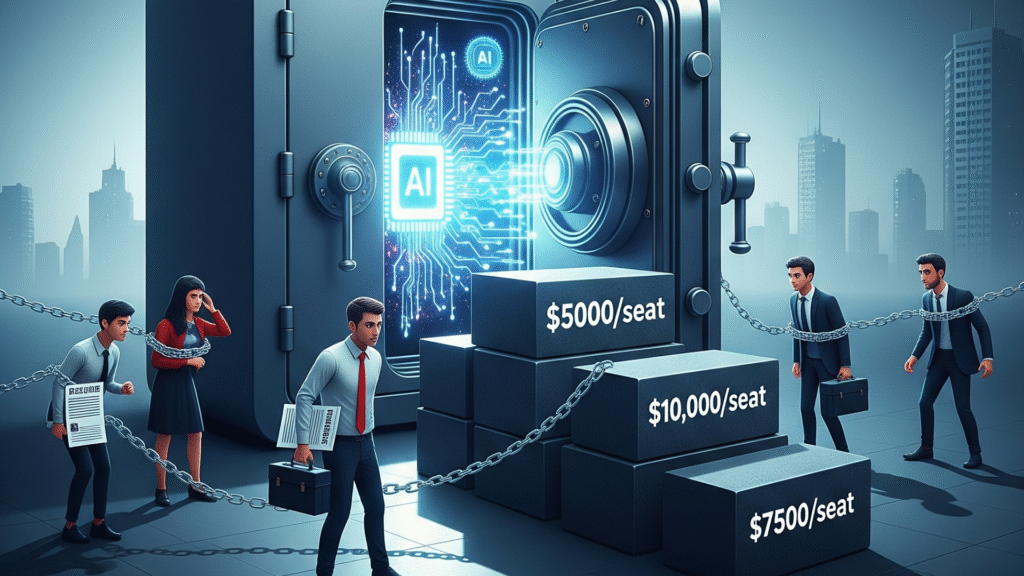Your agency pays $25 per person monthly for ChatGPT Teams. Finance approves AI access for 12 senior staff members. The remaining 18 junior designers, copywriters, account coordinators, and interns get locked out, not because they can’t use AI effectively, but because per-seat economics make it “too expensive.”
This is talent hoarding: artificial barriers that prevent your most adaptable team members from developing AI skills while competitors with democratic access accelerate past you.
Here’s why per-seat pricing creates innovation bottlenecks and how smart agencies are democratizing AI access.
The Economics of Exclusion
How Per-Seat Pricing Creates Access Hierarchy
Typical Agency AI Budget Allocation:
- Senior Leadership: Priority access for strategic oversight
- Senior Creatives: “Essential” for client-facing work
- Account Managers: Client communication requires AI support
- Junior Staff: “Too expensive for entry-level work”
Result: 60-70% of agency talent gets excluded from AI skill development due to cost-per-seat concerns rather than capability limitations.
The Hidden Cost of Talent Restrictions
Research from Workplace Innovation Studies shows that restricting technology access to senior staff creates several penalties:
- Skill Development Stagnation: Junior talent can’t develop AI proficiency for career advancement
- Innovation Pipeline Disruption: Entry-level perspectives often generate creative AI applications that experienced professionals miss
- Competitive Disadvantage: Agencies with broader AI adoption outperform those with restricted access
- Retention Challenges: Talented junior staff seek opportunities offering better AI learning access
The Irony of Junior Talent Restrictions

Why Junior Staff Excel at AI Adoption
Academic research demonstrates that less experienced professionals often adapt faster to new tools than established experts.
Junior Talent Advantages:
- Learning Agility: Fewer established workflows to overcome when integrating AI
- Creative Curiosity: Natural experimentation with AI features and optimization techniques
- Time Availability: Less client management responsibility creates bandwidth for skill development
- Process Innovation: Fresh perspectives identify automation opportunities senior staff overlook
The AI-Enhanced Reality
Traditional Hierarchy:
- Senior staff: Strategy + execution + client management
- Junior staff: Basic execution + learning
AI-Enhanced Outcome:
- Senior staff: Strategy + AI-enhanced execution + client oversight
- Junior staff: Advanced AI collaboration + innovative process development
Junior talent with AI access produces output quality approaching mid-level professionals while developing valuable future skills.
Real-World Impact of Talent Hoarding

The Innovation Bottleneck
Agencies report that AI innovations frequently come from junior team members when given access, not senior staff focused on established client relationships.
Common Junior-Driven Innovations:
- Process Automation: Entry-level staff identify repetitive tasks perfect for AI streamlining
- Creative Experimentation: Junior designers discover novel AI applications for visual concepts
- Client Communication: Account coordinators develop AI-enhanced reporting and updates
- Workflow Optimization: New hires spot inefficiencies that AI can eliminate
The Skill Development Crisis
Without AI experience, junior talent advancement slows as AI proficiency becomes essential for mid-level and senior roles. While junior staff at democratic-access agencies develop expertise, restricted agencies create skill gaps that become competitive disadvantages.
The Democratic AI Access Alternative

Usage-Based vs. Per-Seat Economics
- Per-Seat Challenge: 30-person agency × 25monthly=25monthly=750 for full access, often reduced to 12-15 senior staff to control costs.
- Usage-Based Solution: Same 30-person agency with democratic access where consumption aligns with individual productivity and learning needs.
- Junior Staff AI Usage Patterns:
- Initial Phase: Light usage during learning and experimentation
- Development Phase: Moderate usage as skills improve
- Proficiency Phase: Heavy usage as AI becomes integrated into workflows
Credit-based systems allow costs to scale naturally with skill development rather than requiring upfront per-seat investment.
How Qolaba Eliminates Talent Hoarding

Democratic Platform Access
Qolaba’s credit-based system removes artificial barriers preventing junior talent from accessing AI capabilities:
- Universal Access: All team members get platform access regardless of seniority level
- Natural Usage Scaling: Junior staff exploration consumes minimal credits while developing skills
- Skill Development Support: Built-in tutorials and optimization guidance accelerate proficiency
- Smart Credit Management: Learning-friendly economics with advanced capabilities available as proficiency increases
Enterprise Controls
Team Management:
- Department allocation with usage tracking and optimization insights
- Role-based permissions without per-seat cost penalties
- Skill development analytics showing individual growth and contribution patterns
Innovation Acceleration:
- Cross-level learning where junior insights enhance senior strategy
- Experimentation encouragement through low-risk exploration capabilities
- Innovation documentation capturing breakthrough applications from all team levels
The Competitive Reality

Market Advantage Through Inclusive Access
Agencies successfully democratizing AI access report:
- Faster Project Delivery: Junior staff handling AI-enhanced tasks while seniors focus on strategy
- Enhanced Creativity: Diverse perspectives generating innovative AI applications
- Improved Retention: Talented junior staff staying longer due to superior development opportunities
- Client Differentiation: Broader team AI proficiency enabling sophisticated service offerings
The Talent Development Pipeline
Agencies investing in junior talent AI development build stronger long-term teams while competitors struggle with skill gaps. As AI proficiency becomes essential across all levels, early democratic adoption creates sustainable competitive advantages.
Breaking the Talent Hoarding Cycle

Talent hoarding through AI access restrictions represents strategic short-sightedness that compounds over time. Every month of restricted access means:
- Missed innovation opportunities from diverse creative perspectives
- Slower skill development across organizational talent pipeline
- Competitive disadvantage against democratically accessible competitors
- Retention challenges as talented juniors seek better development opportunities
Transform talent restrictions into competitive advantages through inclusive AI access.
Try Qolaba’s democratic AI platform that scales with talent development rather than restricting it.





